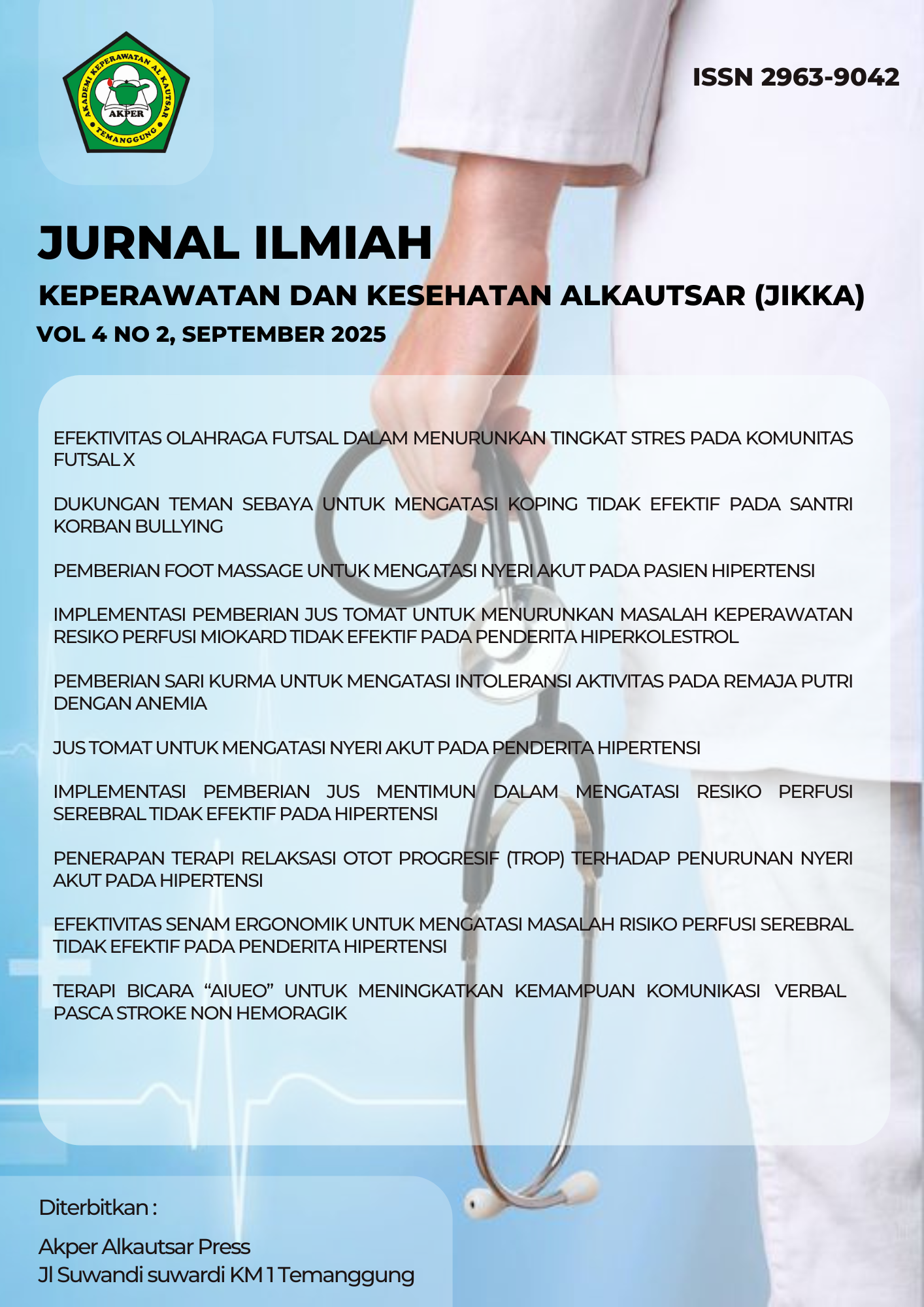APPLICATION OF PROGRESSIVE MUSCLE RELAXATION THERAPY (PMRT) ON THE REDUCTION OF ACUTE PAIN IN HYPERTENSION
DOI:
https://doi.org/10.64314/jikka.v4i2.264Keywords:
hypertension, pain, progressive muscle relaxation therapyAbstract
Background: Hypertension is a disease that causes death. Generally, hypertension affects people of various ages. The WHO in 2019 estimated that about 22% of the world's population suffers from hypertension. Hypertension is a condition in which there is an increase in the sympathetic nervous system. This is due to an increase in the production of catecholamines such as adrenaline and non-adrenaline, which trigger the narrowing of blood vessels, leading to hypertension. Hypertension causes symptoms such as pain in the back of the head, a heavy feeling in the neck, blurred vision to the point of being foggy, difficulty sleeping, fatigue, and pain in the back of the neck. This pain is caused by blockages in the circulatory system from the heart which has a series of arterial and venous blood vessels while carrying blood. Objective: This research aims to determine the application of progressive muscle relaxation therapy to reduce headaches in hypertensive patients. Method: The method used is a qualitative method with a case study design. This research uses instruments such as a mattress or bed, pillows, wall clocks, and a quiet and comfortable environment. In addition, there are assessment formats such as hypertension assessment sheets, acute pain assessment and PQRST, inclusion criteria assessments, pain level evaluation sheets, and standard operating procedure sheets. Results: The results of the analysis show that after implementation for five days, both respondents experienced a decrease in pain levels and blood pressure. This situation is evidenced by the complaints of severe pain decreasing to moderate pain, and systolic blood pressure of ≥140 and diastolic of ≥90 decreasing to systolic of ≤130 and diastolic of ≤86. Conclusion: It can be concluded that progressive muscle relaxation with a frequency of 1 time per day for a duration of 10 minutes for 5 consecutive days can help reduce blood pressure and pain.References
Anggraini, N. R., Nugroho, S. A., & Hafifah, V. N. (2024). Penerapan Teknik Relaksasi Otot Progresif terhadap Penurunan Nyeri Hipertensi pada Lansia di Wisma Seroja UPT PSTW Pandaan Pasuruan. TRILOGI: Jurnal Ilmu Teknologi, Kesehatan, Dan Humaniora, 5(1), 38–46. https://doi.org/10.33650/trilogi.v5i1.7607
Dewi, E. S., Kusuma, A. W., Wihastuti, T. A., Utami, Y. W., Wisnasari, S., & Susanto, A. H. (2021). Strategi Untuk Menurunkan Tingkat Nyeri Dan Stres Warga Kawasan Industri Candi Semarang. Majalah Kesehatan, 8(4), 216–222.
Dewi Puspita H. (2023). Penerapan Terapi Relaksasi Otot Progresif Untuk Menurunkan Nyeri Kepala Pada Penderita Hipertensi. Jurnal Ilmiah Ilmu Keperawatan, 14(3), 1–8.
Ferdisa, R. J., & Ernawati, E. (2021). Penurunan Nyeri Kepala Pada Pasien Hipertensi Menggunakan Terapi Relaksasi Otot Progresif. Ners Muda, 2(2), 47. https://doi.org/10.26714/nm.v2i2.6281
Haryono, R., Permana, I., & Chayati, N. (2020). Pengaruh Kombinasi Pijat Punggung (Back Rub)Terhadap Tingkat Stres Pada Penderita Hipertensi. Jurnal Keperawatan Notokusumo.
Karang. (2018). Efektifitas Terapi Relaksasi Otot Progresif Terhadap Penurunan Tekanan Darah Pada Lansia Dengan Hipertensi. Jurnal Ilmiah Ilmu Keperawatan Indonesia, 339345.
Kemenkes RI. (2020). Profil Kesehatan Indonesia.
Larwuy, M, H., & Azizah, U. (2022). Asuhan Keperawatan Pada Keluarga Tn R Dengan Masalah Hipertensi Pada Ny K Di Wilayah Kerja Puskesmas Pulorejo Kabupaten Mojokerto. Doctoral Dissertation, Perpustakaan UNIVERSITAS Bina Sehat PPNI.
Murniati, M., Sundari, R. I., & Dewi, F. K. (2020). Pelatihan Relaksasi Otot Progresif Pada Kader Posyandu Lansia di Posyandu Lansia RW 05 Desa Kalibagor. Journal of Community Engagement in Health, 3(1), 74–81. https://doi.org/10.30994/jceh.v3i1.39
Notoatmodjo, S. (2018). Metodologi Penelitian Kesehatan.
Olin, B. R., & Pharm, D. (2018). Hypertension : The Silent Killer : Updated JNC-8 Guideline Recommendations.
PPNI. (2018). Standar Luaran Keperawatan Indonesia: Definisi dan Kriteria Hasil Keperawatan (1st ed.). Dewan Pengurus Pusat Persatuan Perawat Nasional Indonesia.
Rahayu, A. (2021). Terapi Komplementer Pada Hipertensi. Pustaka Taman Ilmu.
Rahmat, B. (2022). Penerapan Terapi Relaksasi Otot Progresif Pada Pasien Hipertensi yang Mengalami Gangguan Pola Tidur. Garuda Pelamonia Jurnal Keperawatan, 4, 90–99.
Riskesdas. (2018). Riset Kesehatan Dasar (Riskesdas) 2018 . Badan penelitian dan pengembangan kesehatan kementrian RI tahun 2018.
Sari, I. K., Nur, S. A., Morika, H. D., Sartiwi, W., & Hasrinal. (2022). Pengaruh Pemberian Jus Mengkudu terhadap Penurunan Tekanan Darah pada Pasien Hipertensi di Wilayah Kerja Puskesmas Andalas. Jurnal Kesehatan Saintika Meditory, 4(4657), 78–84.
Sufa, S. A., Christantyawati, N., & Jusnita, R. A. E. (2017). Tren Gaya Hidup Sehat dan Saluran Komunikasi Pelaku Pola Makan Food Combining. Jurnal Komunikasi Profesional, 1(2), 105–120. https://doi.org/10.25139/jkp.v1i2.473
Widari, N. P., & Erika, U. P. (2018). Teknik relaksasi autogenik dan relaksasi otot progresif terhadap tekanan darah pada lansia dengan hipertensi. Ilmu Keperawatan Respati, 4(2), 68–79.
Yarmaiza, & Zakiyuddin. (2019). DOI : https://doi.org/10.36341/jpm.v2i3.794 168 Some rights reserved. Jurnal Pengabdian Masyarakat Multidisiplin, 2(3), 168–175.





.png)



